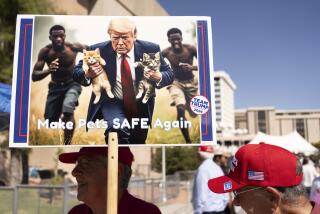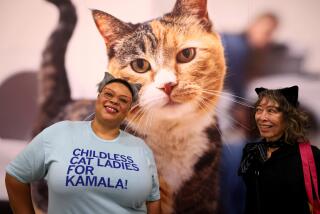It’s Really a Dog’s Life for Cats in Hollywood
An unseen cat is shot with an arrow through an open window, and people laugh. A woman asks a man to dance at a party, and he immediately tosses the cat in his lap clear across the room. People laugh again. A cat gets kicked for no apparent reason by a teen-ager, and even that’s funny to some people.
These are scenes from “A Kid in King Arthur’s Court,” “Nine Months” and “Kids,” respectively--all recent movies, and all movies that would make every cat in Hollywood want to climb a palm tree and never come down.
Kitties have long been in the show-biz doghouse. Movies, TV shows and cartoons have often used felines as the butts of their jokes, and often in violent ways. The renowned sound of a cat screeching is probably one of the most used sound-effect tracks out there. And cats have been used as Frisbees, footballs and twirling toys--all for comic relief.
What is it about harming a cat that some people find humorous? Is it the high-pitched cry they make? Is it the idea that they are such prim-and-proper animals that it’s fun to mess with them? Or is it just that Hollywood is made up of dog lovers?
The latter makes sense since dogs certainly never get harmed the way cats do. Heck, dogs get harmed less often than people do--and if they do get harmed, it can make for a film’s saddest scene (see “Old Yeller”).
“I think dogs are so closely affiliated with human emotions and activities that nobody thinks hurting them is funny,” says Madeline Bernstein, executive director of the Los Angeles Society for the Prevention of Cruelty to Animals. “But cats are still perceived as peculiar little creatures. Their fur stands on end when they get riled and they hiss and scream like they do--for some sad reason, people find that amusing.”
Carrie Freeman, a cat lover who lives in Studio City with her 18-pound feline, Monster, says she was especially disappointed by the haughty, condescending cat depicted in “Babe.” She says this role comes in a long line of cats not getting respectable parts in films, while dogs get all the good leads.
“There are so many movies with dogs as the lovable stars . . . but there really hasn’t been one with a cat that I can think of,” Freeman says. “I think it has a lot to do with the idea that cats are traditionally associated with females, and dogs are associated with males. And since most of the people that make movies are men, they make them on dogs.”
Movies aren’t the only place cats are having trouble getting any respect--cartoons have been equally cruel to the animals. Sylvester always lost out to Tweetie and Jerry always seemed to get an edge up on Tom, but those cartoons were tame compared to current animation hits “The Simpsons” and “Beavis and Butt-head.” In the former, Bart and Lisa’s favorite TV program is “The Itchy & Scratchy Show,” which features a cat constantly being mangled by a mouse.
Beavis and Butt-head’s mistreatment of cats was blamed two years ago after a reported case of someone blowing up a cat.
A spokesperson for MTV, which airs the cartoon, says the network has since limited its run of the cartoon to late-night hours and the show’s creators have taken out arson scenes. “Beavis and Butt-head,” MTV claims, was never meant for young children. And if it’s any consolation to cat lovers, the show also had a scene in which a poodle was put in a running clothes dryer.
Betty Denny Smith, director of the L.A.-based American Humane Assn., says real-life cats are almost never actually harmed on the sets of movies. That’s what her organization makes sure of.
“You don’t actually hear a cat squawk, you hear a recording of a cat squawking,” Smith says. “The cat actors themselves are treated quite well.”
But for many cat lovers and animal rights groups, the damage done to cats in movies and on TV lies mostly in the messages their stories can send.
“It’s so irresponsible,” says Gretchen Wyler, president of the Sherman Oaks-based animal rights group Ark Trust. “Children might think it’s entertaining to hurt a cat. They imitate what they see.”
Ark Trust, which hands out Genesis Awards each year to films with positive animal messages, is one organization that does try to have control over the messages. When “Nine Months” came out in July, the group publicly denounced it for spreading unnecessary fear over the disease toxoplasmosis, a harmful disease to pregnant women that the expecting couple, played by Hugh Grant and Julianne Moore, are warned could come from their cat.
The consensus among veterinarians and obstetricians is that cats are a very minor threat to expectant mothers and that toxoplasmosis can be avoided with a few simple precautions. Wyler says Ark Trust was most concerned that the misinformation in “Nine Months” could leave kitties across the country homeless.
Representatives for 20th Century Fox, which distributed “Nine Months,” and its director Chris Columbus have never publicly commented on the cat issue, and declined to comment for this story. So did the studios for “A Kid in King Arthur’s Court” and “Babe.”
“You’re not going to get anyone here to touch that with a 10-foot pole,” one publicist said of the cat issue.
Is Hollywood afraid there’s going to be a kitty uprising?
“What’s sad is that cats really are harmless,” says cat-lover Freeman. “They give so much happiness to so many people. And look at the thanks they get.”
More to Read
Only good movies
Get the Indie Focus newsletter, Mark Olsen's weekly guide to the world of cinema.
You may occasionally receive promotional content from the Los Angeles Times.










